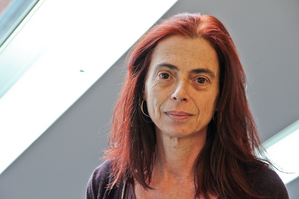Dr. Marie Bels
Curriculum Vitae
Marie Bels holds a Licence de Géographie Urbaine from the Université Louis Pasteur de Strasbourg, France, and a Laurea in Architettura from the Istituto Universitario di Architettura di Venezia (IUAV), Italy. In 2013, she received her doctorate degree in architecture from the Ecole Nationale d’Architecture Paris Malaquais / Université Paris Est, with a thesis entitled “Les grands projets de la justice française. Stratégies et réalisations du ministère de la justice (1991-2001)”. Dr. Bels has taught at several architecture schools, inter alia at Paris-Belleville, Paris-Malaquais and Marseille-Luminy ; and also worked as independent researcher for architects, firms and local communities. In the 1990s, the French Department of Justice commissioned her to complete a study of the “architectural image of justice” which was to emerge from a series of new judicial building competitions. Dr. Bels is also a translator of Italian architecture books into French. From January to August 2014 she completed a post-doctoral stage at the Laboratoire d’étude de l’architecture potentielle (LEAP) of the Université de Montréal. Marie Bels’s research aims to explore the nature of public architecture in democratic contexts through the spatial and symbolic conception of democratic institutions, their relationship with the contemporary city, urban history and collective memory. From January to September 2015, Marie Bels was Fellow at the Käte Hamburger Center for Advanced Study in the Humanities “Law as Culture”.
Research Project
Contemporary Courthouse Architecture: Between Normativity and Spectacularity
Of all the arts, architecture is the most complex and paradoxical, being the art of building forms and spaces that must be at the same time useful and representative. Furthermore, a construction mobilizes the material and intellectual energies of so many people over such a long course of time that we may consider the results, beyond the work of design teams, as a collective product of a social group. In the case of public architecture, it can reveal, as a mirror, how an entire society seeks to represent itself.
New courthouses recently built in Europe have completely broken with the traditional judicial typology. Designed by leading European architects, they are very spectacular in their forms, dimensions and materials, making frequent use of formal transgressions and stage effects. In doing so, they seem to be participating in an image battle heightened by the high media exposure of architecture on a worldwide level.
How does courthouse architecture express the monumentality demanded by the judiciary and politicians as representing an integral part of the judge's role and the status of the institution in an urban space? And what does this say about law and justice in contemporary society?
Furthermore, judicial institutions now face functional requirements that aim to improve performance and quality. This results in a high functionality and flexibility of working spaces, which in turn induces very normative compositional schemes. The architectural results are at the very least paradoxical and thus directly question the didactic power of architectural language, especially as there is no longer one official style or aesthetic principle in the architectural world.
I have been studying this phenomenon since it began in France, in the 1990s, with a series of competitions promoted by the French Department of Justice. During my fellowship, I will continue to integrate the most recent and relevant European architectural experiences into my research. By means of a comparative global analysis of architectural composition and courthouse typologies, I intend to develop accurate tools of knowledge suited for studying the relationships between architecture and justice in a democratic society. Public architecture has a political function, both in the city and in the collective imagination – in particular when it comes to judicial buildings that host funding institutions. If, as I think, a new paradigm in courthouse architecture is now emerging, it may mean that the meaning and the role of law has also changed profoundly. This research will form a central part of a theoretical essay about the architectural image of justice in a multicultural and globalized context.
Selected Publications
- Sur les traces de Ledoux, Marseille: Editions Parenthèses 2004, 190 pp. (a book which reviews the architectural, urban and institutional history of the construction of the courthouse and the prisons of Aix-en-Provence, from 1784 to 1997).
- “Le tribunal de grande instance de Bordeaux”, in: Architecture Créé, no. 284, February 1998, pp. 71-78.
- Autour du Palais. L’histoire en chantier, Exhibition Journées du patrimoine 1997, Palais de Justice d’Aix-en-Provence: Association pour la Restauration et la Sauvegarde du Patrimoine Aixois (ARPA), Ministère de la Justice, Ministère de la Culture, 1997, 50 pp.
- “Questions d’image”, in: Revue des Monuments Historiques, no. 200, February 1996, pp. 42-45.
- “Beau comme l’antique, l’art de Penchaud”, in: Revue des Monuments Historiques, no. 198, September 1995, pp. 66-68.
- “Concours gagnés, concours perdus, vers la fixation d’un type?”, in: Architecture Créé, no. 265, May 1995, pp. 96-103.
- “L’architecture de M.-R. Penchaud, 1803-1833. La vision moderne des origines d’une ville antique”, in: Revue Marseille, no. 164, August 1992, pp. 52-59.
- Translation and Preface of: Bruno Zevi: Le langage moderne de l’architecture, Marseille: Editions Parenthèses, forthcoming.
- Preface for the new French edition of: Giulio Carlo Argan: Gropius et la Bauhaus, Marseille: Edition Parenthèses, currently under press (2014).
- Translation of “Témoignages”, in: Cristiana Mazzoni (ed.): La Tendenza, une avant-garde architecturale italienne, 1950-1980, Marseille: Editions Parenthèses 2013, pp. 90-339.
- Translation and Preface of: Bruno Zevi: Apprendre à voir la ville. Ferrare, la première ville moderne d’Europe, Marseille: Editions Parenthèses 2011, 285 pp.
- Translation of: Vittorio Gregotti: Dix-sept lettres sur l’architecture, Marseille: Editions Parenthèses 2007, 216 pp.
- Translation of: Mario Botta: Ethique du bâti, Marseille: Editions Parenthèses 2005, 125 pp.


